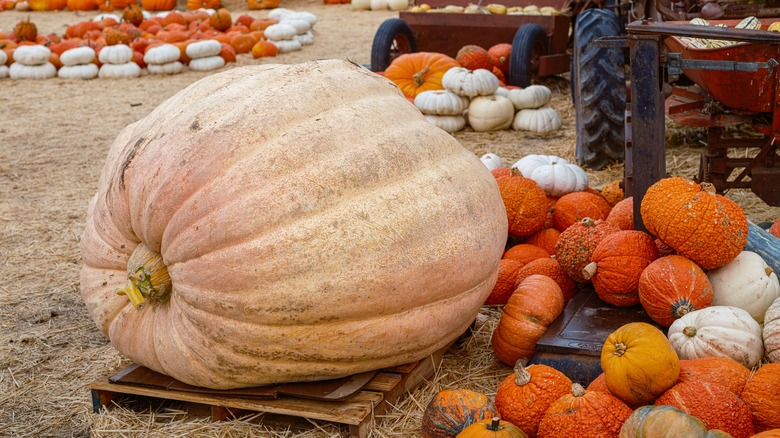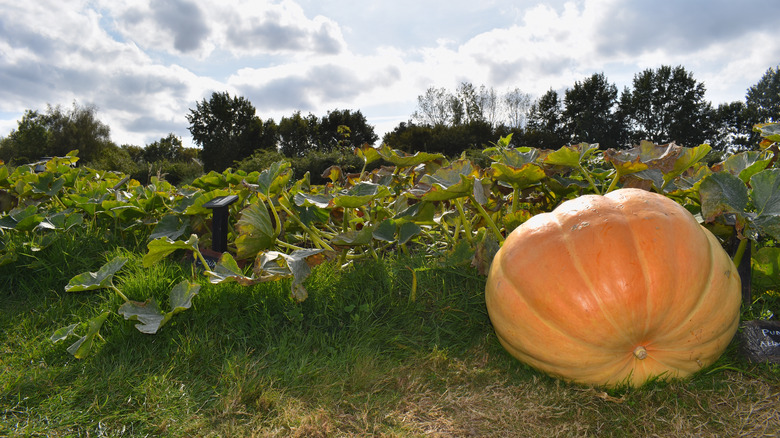The Type Of Pumpkin You Should Plant If You Want A Giant Crop
Have you ever dreamed of growing the biggest pumpkin in the world? With over 150 pumpkin varieties to choose from, there is one particular variety for those seeking the grandest crop of them all — the Dill's Atlantic pumpkin, Cucurbita maxima. These giant pumpkins are synonymous with record-breaking sizes and stupendous autumnal displays. The Dill's Atlantic pumpkin, named after its originator, Howard Dill, hails from Nova Scotia, Canada. Dill, also known as "The Pumpkin King," was a legendary figure in the pumpkin-growing community. With only a seventh-grade education, he taught himself plant genetics and developed this variety over 30 years, ultimately setting a world record in 1980 for the largest pumpkin at 459 pounds.
Dill's Atlantic pumpkins can weigh anywhere from 200 to over 1000 pounds, with the world record currently weighing over 2,600 pounds. They have thick, slightly ribbed, pale orange skin. Dill's Atlantics aren't your beauty contest pumpkins — they look more like lumpy, deflated marshmallows. The pumpkin's flesh is very thick and not the first choice for pumpkin pies or any other culinary purpose. However, these pumpkins are perfect for making monstrous jack-o'lanterns or joining pumpkin competitions.
Growing your giant pumpkin: tips and tricks
Begin with high-quality Dill's Atlantic seeds from a reputable supplier. Look for seeds that have a proven track record of producing large pumpkins. Start the seeds indoors in 12-inch pots at the end of April. About two weeks after the last frost date, plant the seeds in a full-sun sheltered spot. Each plant needs lots of space, so prepare an area of around 20 by 20 feet. These giants require rich, well-draining soil with a pH of 6.5 to 7, and plenty of nutrient-rich compost and manure.
Consistent weekly watering is crucial, especially during dry spells. Feed generously every two weeks with a fish or kelp-based fertilizer to encourage root and fruit development. As the plant grows, prune it to focus energy on a single pumpkin. Remove any vines, female flowers, and fruits to direct nutrients to the chosen giant. Due to their size, these pumpkins can stress their vines which can grow up to 50 feet long.
Regularly inspect plants for pests and signs of disease. Atlantic Dill's pumpkins are prone to powdery mildew, so watch out for white spots on leaves and treat them accordingly. Organic pesticides and fungicides can help, and if you sprinkle a little epsom salt, your pumpkin will thank you. Providing a bed of straw or a soft mat can prevent damage from the ground and help with moving your pumpkin later on. Your Dill's Atlantic showstopper will be ready for harvest in around four months.
Challenges and considerations for the Dills Atlantic
While growing Dill's Atlantic pumpkins can be incredibly rewarding, it's not without its challenges. Their sheer size means they require more care and resources than typical pumpkin varieties. Just one pumpkin can require 1,200 square feet of land and up to 500 gallons of water per week! They are also more susceptible to diseases and pests due to their long growing period and the large amount of foliage they produce. Additionally, considering the space requirements, this variety may not be suitable for small gardens or those with limited growing space.
If you want to join the big pumpkin club and flaunt a giant crop, Dill's Atlantic is the sure way to do it. One of the most exciting things about growing these pumpkins is the sense of community and competition it fosters. Growers often share tips, seeds, and stories in various online forums and gardening clubs. Moreover, pumpkin growing competitions, where Dill's Atlantics are often featured, provide a platform for growers to showcase their months of hard work and dedication.


